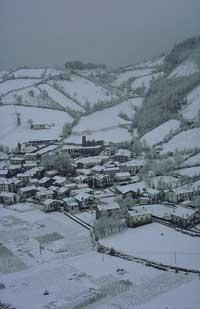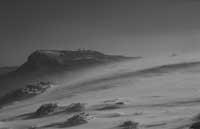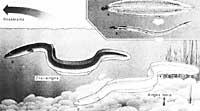New fans: January
1998/01/01 Elosegi Irurtia, Migel M. Iturria: Elhuyar aldizkaria
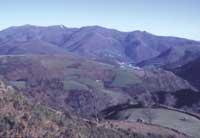
January or black moon is the winter month. While there is no snow, the mountains do not show their most beautiful appearance. Most of the leafy trees lost the leaves and the bare trees give a cold feeling to the leafy forests. In the repopulated pine forests of Bizkaia and Gipuzkoa, some species may find good protection, but much better in the native forests that support the leaf, such as the coast, the oaks of Navarre and Alava, the Pyrenean pine forests, etc.
The low temperatures make us in a time of bad weather to see reptiles or amphibians. In colloquial language, we say that these animals are “cold blood”, since their metabolic rate is very low and they are not able to produce body heat. Thus, by eliminating the red wild frogs or palmate tritons that could begin to reproduce and, as long as there is no extraordinary heat, most cold-blooded animals hide in some hole and wait for more temperate times. At the same time, insects and, in general, invertebrates do not look excessively. Many of them spend the winter in the form of egg or larva and adults who are outside are not in the fastest time. At home, for example, we have few cushioned flies and, unlike what happens in summer, it is easy to remove them with a blow when patches are put on.
Fish Tickets
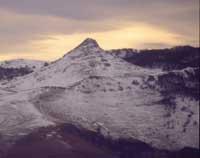
In the unpolluted rivers of the Atlantic slope, such as the Bidasoa, Errobi, Aturri, etc., elegant fish begin to be introduced from the sea. After several years at sea and driven by reproductive instinct, salmon have approached from the waters near Greenland to the waters where they were born. So, to enter the river and adapt to the different salinity of the water, gradually they go up in search of the place where they will lay their eggs next autumn. Without despairing, they overcome intermediate obstacles with spectacular jumps to ascend.
From sea to river up, but doing the cycle against the salmon, the angles arrive. They were born in the sea of Sargazos three years ago, and after a 7,000 kilometer journey, they begin to climb the rivers to grow and become eels. For the misfortune of the angles, in the surroundings we appreciate them very much and in 1997 the kilo was sold to about 40,000 pesetas. For example, at a time when the day of San Sebastian is approaching, there is a lot of demand and many people strive to fish these gold fish. Consequently, of course, these famous eel larvae are under heavy pressure (perhaps too big).
Running with winter clothes
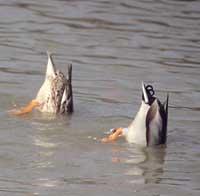
We have already said that this month can be fine cold. To cope with this problem there may be multiple adaptations, but in general animals have taken steps to protect their bodies from the outside environment. Many birds have collected a fat or fat cap that will be the reserve of the reddest times. The plumage is also more compact and often the feathers take pride in the warm layers of air to release them from the cold outside wind.
Mammals also in the previous months tried to eat bapo and accumulate energy and, in general, have dressed in longer hair and more compact skin. The deer has darker skin, the ears of the squirrel are very hairy and the squid of the sheep has also lengthened quite. In addition, fleeing fame, many animals will move to the calendar in the hope of the sun's rays.
And some eager to reproduce!
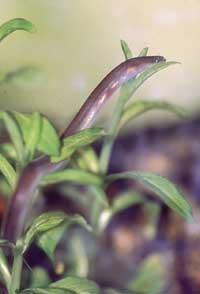
On the rocky cliffs, however, it is surprising, but the reproduction of our larger birds has begun. Although they can put it between December and February, most griffon vultures and mammals will place the egg in January. Nests, in inaccessible ravines, are placed in rock holes and ledges and one of the parents is completely above to prevent the egg from cooling. If you are mountaineers and especially climbers, bear in mind that in reproductive times it is not advisable to travel through the nests of these scavengers.
As for mammals, and among those who initiate zeal, we can cite the fox and the hare. From time to time the hairs of the latter are found on the mountain, witnesses of the clashes that usually have the males in competition with the females.
Migration and bird-filled wetlands completed
Postbridal migration ended. Most birds passed over us in late summer and autumn, although there may still be large bird entrances. As soon as the north wind enters central and northern Europe and snow storms begin, many birds move to these latitudes, among which are the calves, planes and ducks. The Basque Country is a relatively mild country, and if we leave alone, we are satisfied for a season. Thus, many places are covered with birds and, for example, in the Alava reservoirs or in Navarros wetlands, during the month of January ten thousand ducks, copetazines and waterfowl can meet.
It is time to take binoculars and watch birds in the Ullíbarri reservoir. Also in Urdaibai, Pitillas, Biarritz or Txingudi, it can be a good time to observe these birds.
In the Pyrenean area there is no environment
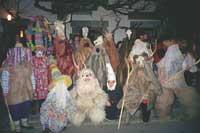
Although winter on our coast is relatively mild, in the high mountain it can be terrible. Without worrying too much about the outside environment in the Pyrenean area of Euskal Herria, we have the bear (if any) and the marmot, the snoring. However, not all Pyrenean animals are able to hibernate. The Sarrians, for example, have descended from the high mountain in search of places with less snow and have found refuge in the forest. In addition to entering temperate areas of trees, they look for clean slopes by the wind to find grass.
The roe deer are also tucked into forests and bushes and at this time the branches of the males are lengthening. Around Azaro, like every year, they lost their horns and now they have begun to grow covered with a veil.
What about humans?
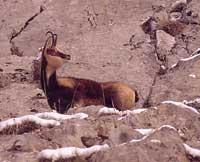
The human being is finally calm. About three months ago the shepherds lowered the livestock of the pastures superior to those of the house and barely remain in the orchards. It can be fun time and it is so in many places. In this area of the day of San Sebastian start the festivities galantes, the season of cider shops and carnivals in several locations. A good time to see the curious customs of the human being!

Gai honi buruzko eduki gehiago
Elhuyarrek garatutako teknologia



